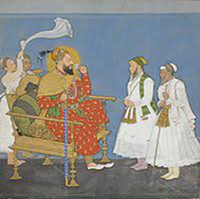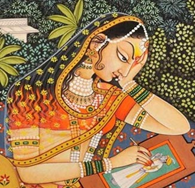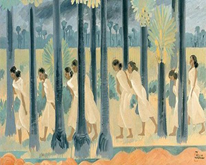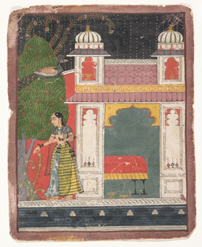

Context:
The Indian art historian Brijinder Nath Goswamy, best known for his scholarship on Indian miniature painting tradition, passed away at 90.
Who was Brijinder Nath Goswamy?
- A Padma Bhushan recipient and former IAS officer, he first came under the spotlight after the publication of his ground-breaking 1968 article, ‘Pahari Painting: The Family as the Basis of Style’.
- In his piece, he unearth family lineages of renowned artists who played an essential role in the development and continuation of miniature painting — the revelation was one of his biggest contributions to the history of miniature paintings in India.
A look at the tradition of Indian miniature painting:
- Miniature paintings, characterized by their small size and vibrant colours, are intricately crafted handmade artworks.
- The term "miniature" originates from "minimum," underscoring their diminutive scale. These artworks employ diverse materials, ranging from paper and palm leaves to wood and marble.
- The impetus behind the prevalence of miniature paintings can be traced to the religious teachings of Buddha, which included the depiction of his images inscribed on palm leaves.
- The necessity for these paintings to be compact arose from the need to accommodate them on palm leaves, the medium of their creation. Around 960 A.D., the Chalukya Dynasty kings introduced similar paintings to western India.
- Beyond their size, these paintings also portrayed religious themes, capturing the essence of spiritual narratives.
- The surge in the popularity of miniature paintings coincided with the Mughal Empire's expansion, fueled by Akbar's profound interest in this art form.
Exploring the Tradition of Miniature Painting:
- Historical Roots and Evolution: The intricate art of miniature painting traces its origins back to the Buddhist Pala dynasty, flourishing during the 8th to 11th centuries in Bengal and Bihar.
- Initially, these paintings adorned religious texts, transitioning from palm leaves to paper between the 11th and 13th centuries.
- However, it wasn't until the Mughal Empire's rise in the early 1500s that the tradition gained prominence.
- Mughal Influence and Decline: Under the patronage of Humayun and his descendants, Mughal miniatures became synonymous with sophistication. These tiny, brightly colored artworks, often no larger than a few square inches, adorned manuscripts and art books.
- The meticulous details, some painted with brushes of a single hair, made them highly esteemed. However, the tradition saw a decline during Aurangzeb's rule, prompting skilled artists to migrate to princely courts in Rajasthan and the Himalayan regions.

- The meticulous details, some painted with brushes of a single hair, made them highly esteemed. However, the tradition saw a decline during Aurangzeb's rule, prompting skilled artists to migrate to princely courts in Rajasthan and the Himalayan regions.
- Rise of Pahari Painting: The shift led to the emergence of Pahari painting in places like Himachal Pradesh, Jammu, Tehri-Garhwal, and Rajasthan. Pahari paintings encompassed both religious and secular subjects, portraying detailed scenes from epics like Mahabharata and Ramayana. Unlike the Mughal court's diverse influences, Pahari paintings retained a distinctive family-based style.
- Deccan Painting: In the Deccan region between the 16th and 19th centuries, Deccani miniature paintings developed independently after the dissolution of the Bahmani Sultanate in 1520. Drawing inspiration from European, Iranian, and Turkish influences, Deccani paintings illuminated texts from the Holy Quran and Surahs. Over time, indigenous elements and romantic themes were incorporated into this evolving art form.

Goswamy's Contribution to Miniature Painting Knowledge Expansion:
- Family-Centric Styles: Notably, art historian Goswamy, in a 1968 article focusing on Pahari painting, emphasized that painting styles were not tied to geographical regions but rather to families of painters. Unlike the Mughal court, where styles weren't family-centric, Goswamy's insights illuminated the family networks that shaped the distinctive Pahari style.
- Reconstructing Artist Networks:Goswamy's contribution extended beyond Pahari painting to encompass artists from various regions. Using a combination of detective work and intuition, he reconstructed entire family networks of renowned Indian miniature painters. By aligning inscriptions on miniatures with pilgrim records from Haridwar, he breathed life into previously obscure artists, giving them names and restoring their identities.
AnalyzingGoswamy's Impact:
- Historical Restoration: Goswamy's work didn't merely delve into art; it became a historical restoration project. By piecing together fragments of evidence, he revived the dynasties and identities of artists who had faded into obscurity.
- Recognition of Artistic Lineages:His research not only identified individual artists but also traced the lineage of artistic families, acknowledging the collective contributions of generations. This recognition added depth and context to the understanding of miniature paintings.
- Preservation of Cultural Heritage: In restoring names and identities, Goswamy contributed to preserving the cultural heritage embedded in these miniature paintings. The artists, once nameless, became integral parts of India's artistic legacy.
Famous miniature Paintings in India:
|
School of Painting |
Description |
|
1. Rajput School |
|
|
2. Mughal School |
|
|
3. Deccan School |
|
|
4. Bengal School
|
|
|
5. Malwa School |
|
Conclusion
Goswamy's meticulous work expanded our understanding of miniature paintings by revealing the intricate family dynamics that shaped these artistic traditions, ensuring that the legacy of these artists endures in historical narratives.







